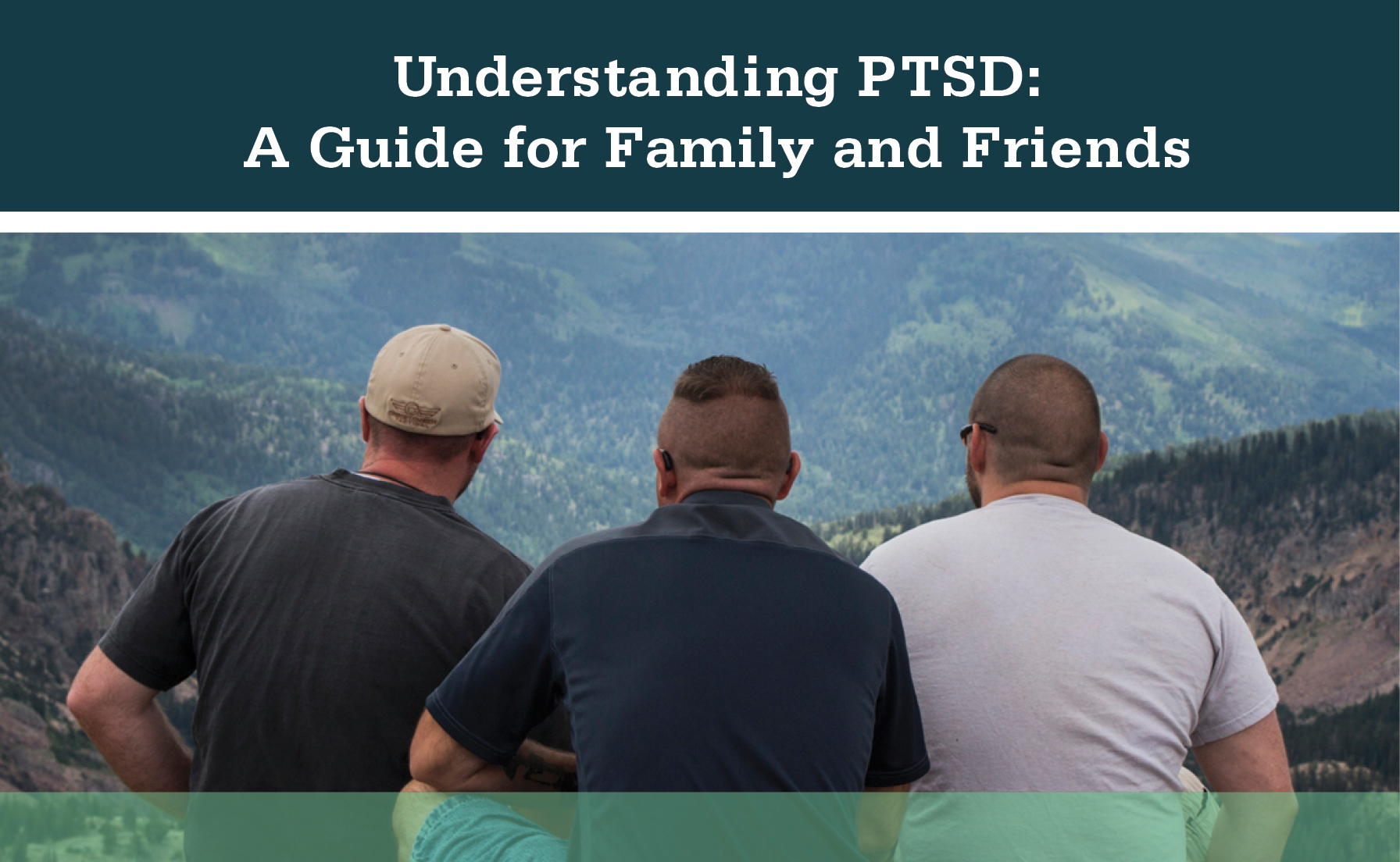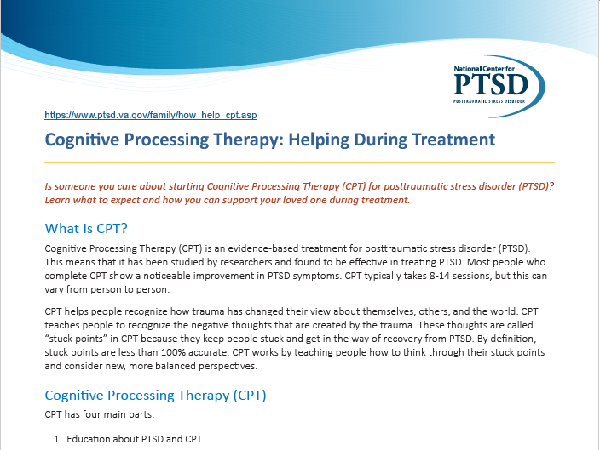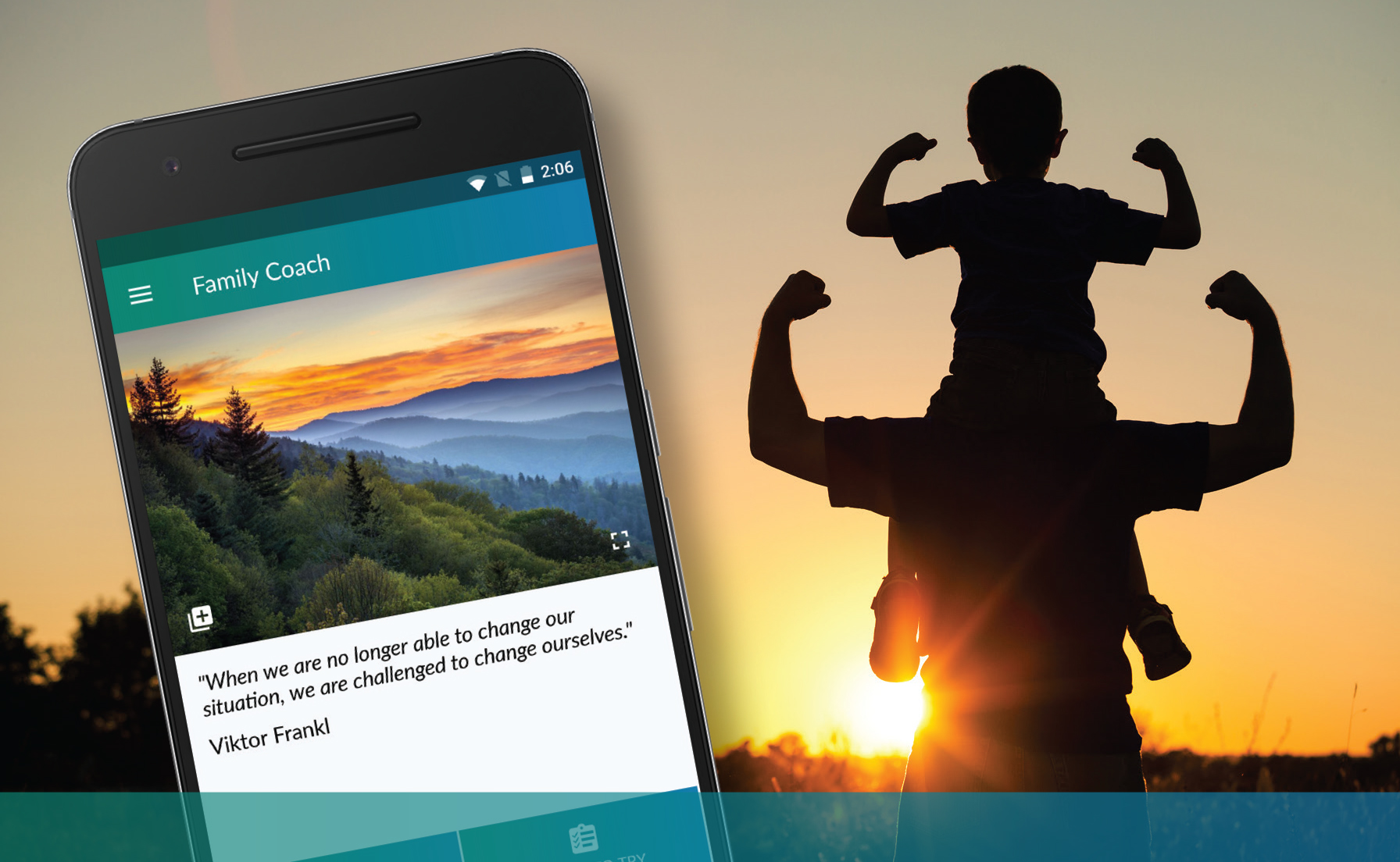PTSD: National Center for PTSD
Cognitive Processing Therapy: Helping During Treatment
Cognitive Processing Therapy: Helping During Treatment
Available en Español
Is someone you care about starting Cognitive Processing Therapy (CPT) for posttraumatic stress disorder (PTSD)? Learn what to expect and how you can support your loved one during treatment.
Reading time: minutes
What Is CPT?
Cognitive Processing Therapy (CPT) is an evidence-based treatment for posttraumatic stress disorder (PTSD). This means that it has been studied by researchers and found to be effective in treating PTSD. Most people who complete CPT show a noticeable improvement in PTSD symptoms. CPT typically takes 8-14 sessions, but this can vary from person to person.
CPT helps people recognize how trauma has changed their view about themselves, others, and the world. CPT teaches people to recognize the negative thoughts that are created by the trauma. These thoughts are called "stuck points" in CPT because they keep people stuck and get in the way of recovery from PTSD. By definition, stuck points are less than 100% accurate. CPT works by teaching people how to think through their stuck points and consider new, more balanced perspectives.
What Is CPT?
CPT has four main parts:
- Education about PTSD and CPT
- Processing the trauma
- Learning to challenge thoughts about the trauma
- Trauma themes
1. Education about PTSD and CPT
CPT starts with education about PTSD and common ways people respond to trauma. The therapist will ask about the symptoms your loved one has, explain how CPT works, and discuss the goals of treatment. Most importantly, your loved one will learn about the ways thoughts about the trauma, oneself, the world, and others can affect emotions. You can help by:
- Learning about trauma, PTSD, and CPT. Knowing the basics is a great place to start. There are resources listed at the end of this page to help you start learning.
- Asking your loved one if to talk about treatment and respecting the answer. You are providing support by asking to talk even if your loved one is not ready to do so.
2. Processing the trauma
The therapist and your loved one will focus on thinking through parts of the trauma memory. Depending on the type of CPT, the therapist may ask your loved one to write a description of the trauma, called a trauma account. Writing and re-reading this trauma account helps many people feel their feelings related to the trauma and identify stuck points created by the event. You can help by:
- Understanding that many people may prefer to keep the details of their trauma private.
- Allowing your loved one time to read and write the trauma account privately.
- Reminding yourself it is ok if your loved one gets upset when thinking about the trauma. Being upset does not mean that the treatment is not working. With treatment, thinking about the trauma will get easier over time. Many survivors were not able to feel their feelings (such as sadness or fear) during the traumatic event. Reading the account often allows people to feel these feelings now that the trauma is over and they are in a safe place.
- Encouraging your loved one to face the difficult or uncomfortable feelings may actually help them stick with and finish the treatment.
3. Learning to challenge thoughts about the trauma
An important part of CPT is identifying thoughts that get in the way of recovery from PTSD. In addition to the work done during therapy sessions, your loved one will complete worksheets at home. These worksheets help people identify and examine their thoughts about the trauma. You can help by:
- Providing support if your loved one is nervous about doing the worksheets.
- Recognizing that your loved one may be more interested in doing things that were avoided before treatment began. If so, support your loved one in becoming more involved in daily life.
4. Trauma themes
During the last several sessions of CPT, your loved one will focus on 5 themes: safety, trust, power and control, esteem, and intimacy. Often, people with PTSD have problems in one or more of these areas. For example, they may think that they are never safe, or that no one can be trusted. Your loved one will complete worksheets on each of these themes, and will talk about thoughts related to these themes with their therapist. You can help by:
- Being aware that your loved one will be thinking more about these themes.
- Making yourself available to talk about the themes if your loved one wants to.
Wrap Up
CPT is effective in treating PTSD. Your loved one's decision to think about or start CPT is a great first step in recovery. Understanding the basics of CPT will help you support your loved one during the treatment process.
Printable Handout
Cognitive Processing Therapy: Helping During Treatment
Download a PDF of this page which discusses what to expect and how you can support your loved one during Cognitive Process Therapy treatment.
Additional Resources
There are videos and programs to support family members or help you learn about trauma, PTSD, and PTSD treatments like CPT. We recommend:
- AboutFace: Learn about PTSD from Veterans who've experienced it. Listen to their stories and find out how treatment turned their lives around. Hear from family members and clinicians as well.
- Animated Whiteboard Videos: Short videos that use hand-drawn images to describe PTSD and effective treatments, including CPT.
- Understanding PTSD: A Guide for Family and Friends | Available en Español (PDF): Booklet that includes what you need to know to help yourself and your loved one with PTSD.
- PTSD Family Coach App: Mobile app designed to provide support for concerned family members of those with PTSD.
- VA Caregiver Support: Program to help you care for the Veteran you love and for yourself.
You May Also Be Interested In

Understanding PTSD: A Guide for Family and Friends (PDF)
What you need to know to help yourself and your loved one with PTSD.


























